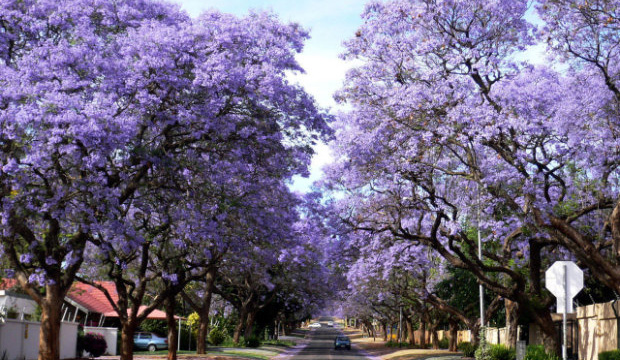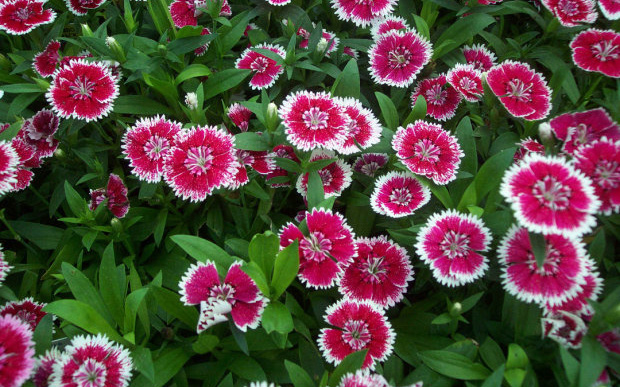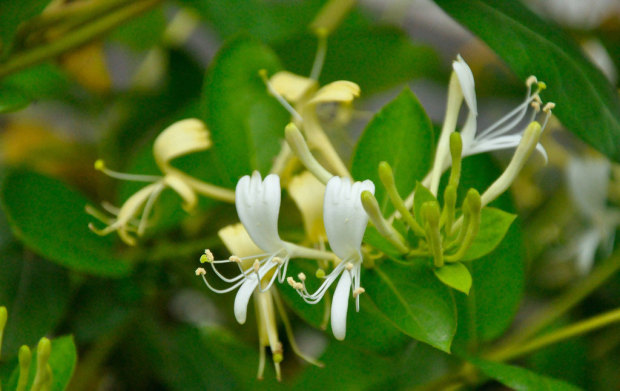Cultivation and culture management method of jacaranda jacaranda
Blue flower is native to tropical America. It likes warm, humid, sunny environment and is not resistant to frost and snow. The suitable growth temperature is 22 to 30 ℃. If the winter temperature is lower than 15 ℃, the growth will stagnate. If it is lower than 3 to 5 ℃, it will cause chilling injury. If the summer temperature is higher than 32 ℃, the growth will also be inhibited. If you like the light, you can withstand the half-yin. First, temperature and light: blue flower is native to tropical America, likes warm, humid, sunny environment, and is not resistant to frost and snow. The suitable growth temperature is 22 to 30 ℃. If the winter temperature is lower than 15 ℃, the growth will stagnate. If it is lower than 3 to 5 ℃, it will cause chilling injury. If the summer temperature is higher than 32 ℃, the growth will also be inhibited. If you like the light, you can withstand the half-yin. Second, soil and fertilization; like fertile and moist sandy loam or loam, adequate basal fertilizer should be applied when planting, topdressing once in spring and autumn after survival, pruning once in early spring every year, and heavy pruning should be applied to aged plants. When potted, it can be dried or grafted and dwarfed, and watering and nitrogen fertilizer can be controlled.

Third, pest control: the disease of the blue flower is less, and the insect pests are mainly longicorn beetles. if it is found that there are reddish-brown dung shavings at the base of the trunk, you can use a knife to pick up the bark cortex to catch the larvae; or before the occurrence of adults, apply a mixture of 10 parts of quicklime, sulfur and salt below 80 cm below the base of the trunk to prevent adults from laying eggs. Ornamental value: foliage and flowering tree species, widely planted as street trees, shade trees and scenic trees in tropical and warm subtropical areas. Bloom once a year in summer and autumn, full of purple-blue flowers in full bloom, very elegant and beautiful, especially in the tropics, blue-flowered trees are rare, so blue flowers are actually a rare and rare woody flower. The wood is soft and is a good material for making wood carving handicrafts. Economic use: Wood can be made into furniture. . The wood is soft and is a good material for making wood carving handicrafts. Blue flower language: represents serenity, far-reaching, hesitation. Propagation and culture methods of blue flower mackerel
Blue vetch, a tree species introduced and cultivated in China in recent years, belongs to woody plants. It blossoms once a year in summer and autumn, with purple-blue flowers in full bloom, and is very elegant and beautiful, especially in the tropics. Blue-flowered trees are rare, so blue flowers are a rare and rare woody flower. So, how do blue flowers breed? What are the breeding methods of blue flower mackerel? Let's take a look at it.
The Propagation method of Scutellaria paniculata
The propagation methods of Carpinus przewalskii are divided into sowing propagation, cutting propagation and tissue culture propagation. The capsule matured in November, exposed or stacked in a windless place after harvest, dried and stored until March of the following year, and sowed when the temperature was around 20 ℃, but the seed germination rate was only about 5%. Cuttage propagation of Scutellaria paniculata can be carried out in both spring and autumn, and medium-mature branches are selected as cuttings with high rooting rate.
1. Sowing and reproduction
The fruit ripening period of the blueflower is in November. After picking, the fruit should be exposed to the sun or stacked in a windless place, dried and then stored, and sown in March of the following year. Because the blueflower is native to the tropics, sow seeds at a temperature of about 20 degrees.
2. Cuttage propagation
The cuttings can be propagated in both spring and autumn, and medium-ripe branches should be selected as cuttings when cutting, so that the rooting rate is high.
3. Tissue culture and propagation.
Tissue culture is also easy. Some scientific research institutions in China have used the stem top and stem segments of seedlings as explants to propagate a large number of test-tube plantlets.
The culture method of blue flower mackerel
1. Temperature and light
Blue flower is native to tropical America. It likes warm, humid, sunny environment and is not resistant to frost and snow. The suitable growth temperature is 22 to 30 ℃. If the winter temperature is lower than 15 ℃, the growth will stagnate. If it is lower than 3 to 5 ℃, it will cause chilling injury. If the summer temperature is higher than 32 ℃, the growth will also be inhibited. If you like the light, you can withstand the half-yin.
2. Soil and fertilization
For the fertile and moist sandy loam or loam, sufficient basal fertilizer should be applied when planting, topdressing once in spring and autumn after survival, pruning once in early spring every year, and heavy pruning should be applied to aging plants. When potted, it can be dried or grafted and dwarfed, and watering and nitrogen fertilizer can be controlled.
3. Pest control
The disease of blue flower is less, and the insect pests are mainly longicorn beetles. if reddish-brown dung shavings are found at the base of the trunk, a knife can be used to pick up the bark cortex to catch larvae; before the occurrence of adults, a mixture of 10 parts of quicklime, 1 part of sulfur and salt can be applied below 80 cm of the trunk to prevent adults from spawning.
The cultivation and cultivation of dense-colored brilliant blue flowers, the crown is tall, the plant height can reach more than 15 meters, leaves alternate, bipinnately compound leaves, leaflets small, pinnate, closely inserted, quite beautiful. Terminal or axillary panicle of numerous dark blue or purplish flowers covered with spectacular branches. Each inflorescence can be up to 20 cm long, with dozens of flowers, bell-shaped flowers. Capsule.
Culture: blue flowers are cultured by seed, cutting tissue culture and other methods. The capsule matured in November, exposed or stacked in a windless place after harvest, dried and stored until March of the following year, and sowed when the temperature was around 20 ℃, but the seed germination rate was only about 5%. Cuttage culture of Scutellaria paniculata can be carried out in both spring and autumn, and medium-mature branches are selected as cuttings with high rooting rate. The tissue culture of blue flower is also easy. Some scientific research institutions in China have used the stem top and stem segments of seedlings to cultivate a large number of test-tube plantlets for exozoites. Cultivation: (1) temperature and light: blue flower is native to tropical America, likes warm, humid, sunny environment, and is not resistant to frost and snow. The suitable growth temperature is 22 to 30 ℃. If the winter temperature is lower than 15 ℃, the growth will stagnate. If it is lower than 3 to 5 ℃, it will cause chilling injury. If the summer temperature is higher than 32 ℃, the growth will also be inhibited. If you like the light, you can withstand the half-yin. (2) soil and fertilization; for sandy loam or loam which likes fertile and humid soil, sufficient basal fertilizer should be applied when planting, topdressing once in spring and autumn after survival, pruning once in early spring every year, and heavy pruning should be applied to aged plants. When potted, it can be dried or grafted and dwarfed, and watering and nitrogen fertilizer can be controlled. (3) Prevention and control of diseases and insect pests: there are few diseases of blue flowers, and longicorn beetles are the main pests. If reddish-brown dung shavings are found at the base of the trunk, a knife can be used to pick up the bark cortex to catch larvae; or before the occurrence of adults, the mixture of 10 parts of quicklime, sulfur and salt at the base of the trunk below 80 cm can be applied to prevent adults from spawning.
- Prev

Cultivation and Culture methods of Carnation
The branches of carnation flowers are as slender and green as bamboo; the flowers are light red, red and white, and the petals are rich in velvet trimmed with velvet, rich and varied colors; many varieties of flowers also have elegant fragrance. The famous Tang Dynasty poets Li Bai and du Fu both wrote poems about carnation embroidery, Luo Yi and Musk Sleeping Carnation, praising the beauty of carnation.
- Next

Cultivation and Culture methods of Flos Lonicerae
Honeysuckle is also called honeysuckle vine, mandarin duck vine or double flower, because it is a kind of vine, the flower is snow-white at first, then golden, and it is also called honeysuckle because its leaves do not wither through winter, the new leaves will come out in spring, and the old leaves will slowly fall away. Its rattan branches can be wound around other things
Related
- Fuxing push coffee new agricultural production and marketing class: lack of small-scale processing plants
- Jujube rice field leisure farm deep ploughing Yilan for five years to create a space for organic food and play
- Nongyu Farm-A trial of organic papaya for brave women with advanced technology
- Four points for attention in the prevention and control of diseases and insect pests of edible fungi
- How to add nutrient solution to Edible Fungi
- Is there any good way to control edible fungus mites?
- Open Inoculation Technology of Edible Fungi
- Is there any clever way to use fertilizer for edible fungus in winter?
- What agents are used to kill the pathogens of edible fungi in the mushroom shed?
- Rapid drying of Edible Fungi

